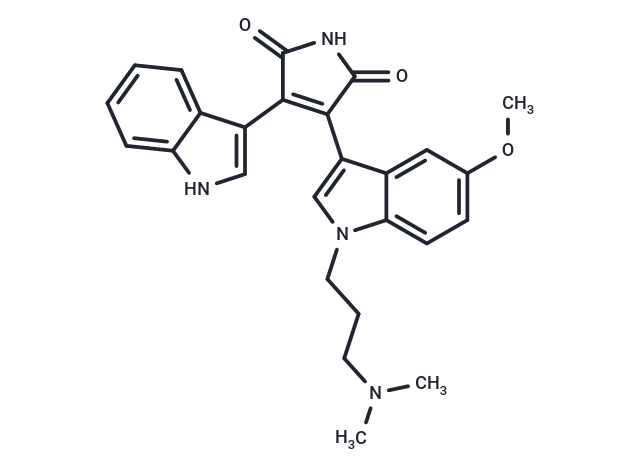Shopping Cart
- Remove All
 Your shopping cart is currently empty
Your shopping cart is currently empty

Go 6983, a pan-PKC inhibitor, targets PKCα, PKCβ, PKCγ, PKCδ, and PKCζ, with IC50 values of 7 nM, 7 nM, 6 nM, 10 nM, and 60 nM, respectively.

| Pack Size | Price | Availability | Quantity |
|---|---|---|---|
| 1 mg | $36 | In Stock | |
| 2 mg | $50 | In Stock | |
| 5 mg | $76 | In Stock | |
| 10 mg | $128 | In Stock | |
| 25 mg | $258 | In Stock | |
| 50 mg | $408 | In Stock | |
| 100 mg | $593 | In Stock | |
| 1 mL x 10 mM (in DMSO) | $80 | In Stock |
| Description | Go 6983, a pan-PKC inhibitor, targets PKCα, PKCβ, PKCγ, PKCδ, and PKCζ, with IC50 values of 7 nM, 7 nM, 6 nM, 10 nM, and 60 nM, respectively. |
| Targets&IC50 | PKCζ:60 nM, PKCβ:7 nM, PKCα:7 nM, PKCγ:6 nM, PKCδ:10 nM |
| In vitro | A 22.0 μg intravenous (i.v.) dose of Go6983 significantly inhibits 51.2% of tumor metastasis in the B16BL6 lung tumor model in mice. |
| In vivo | Go 6983 is a subtype-specific PKC inhibitor that targets the ATP binding site. It inhibits ΔPfPKB activity with an IC50 of 1 μM. When 1 μM Go 6983 is used in conjunction with 390 nM Ro-31-8425, it slightly inhibits Angiotensin II-induced PLD2 activity in PGSMCs. Treatment with Go 6983 (5 μM) results in significantly fewer cycles in the next generation compared to control cultures, and this treatment leads to a nearly 60% reduction in new ring formation in cultures of the malaria parasite. At a concentration of 300 μM, Go6983 decreases PKCμ autophosphorylation by 20% in NIH3T3 cells transfected with PKCμ. In scenarios involving cardiac reperfusion, treatment with Go6983 (100 nM) alongside PMNs restores left ventricular developed pressure and the rate of left ventricular pressure development to 89% and 74% of baseline values, respectively, significantly higher than treatment with PMNs alone. Compared to cardiac ischemia-reperfusion (I/R) + PMN, 100 nM Go6983 significantly inhibits PMN adhesion to endothelial cells and myocardial infiltration and reduces superoxide release by PMNs by 90%. Go6983 reduces myocardial contractile dysfunction after I/R in the presence of PMNs, likely due to reduced superoxide production. It notably inhibits superoxide release from leukocytes in patients previously sensitized to tree pollen antigens. Furthermore, Go6983 inhibits Ca(2+) accumulation in human vascular tissue cells, indicating its mechanism for vascular relaxation properties. |
| Kinase Assay | Phosphorylation reactions are carried out in a total volume of 100 μL, containing buffer C (50 mM Tris-HCl, pH 7.5, 10 mM β-mercaptoethanol), 4 mM MgCl2, 10 μg PS, 100 nM TPA, 5 μL of a Sf158 cell extract as a source of recombinant PKCμ or of Sf9 cell extracts as a source of other recombinant PKC isoenzymes, 10 μg of syntide 2 as substrate, and 35 μM ATP containing 1 μCi [γ-32P]ATP. In some experiments, PS and TPA are omitted or various inhibitors at concentrations indicated in the text are added. After incubation for 10 min at 30°C, the reaction is terminated by transferring 50 μL of the assay mixture onto a 20 mm square piece of phosphocellulose paper, which is washed 3 times in deionized water and twice in acetone. The radioactivity on each paper is determined by liquid scintillation counting. |
| Alias | Goe 6983 |
| Molecular Weight | 442.51 |
| Formula | C26H26N4O3 |
| Cas No. | 133053-19-7 |
| Smiles | COc1ccc2n(CCCN(C)C)cc(C3=C(C(=O)NC3=O)c3c[nH]c4ccccc34)c2c1 |
| Relative Density. | 1.31g/cm3 |
| Storage | Powder: -20°C for 3 years | In solvent: -80°C for 1 year | Shipping with blue ice. | |||||||||||||||||||||||||
| Solubility Information | DMSO: 22.1 mg/mL (49.94 mM), Sonication is recommended. | |||||||||||||||||||||||||
Solution Preparation Table | ||||||||||||||||||||||||||
DMSO
| ||||||||||||||||||||||||||

Copyright © 2015-2025 TargetMol Chemicals Inc. All Rights Reserved.